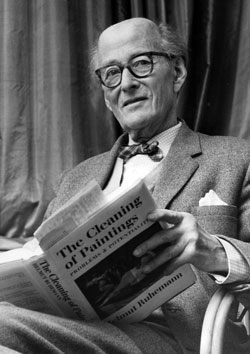Helmut Moritz Ruhemann (1891 - 1973) was one of the leading picture restorers of his generation.
Bibliography
Helmut Moritz Ruhemann was one of the leading picture restorers of his generation. Born in Berlin he studied painting in Karlsruhe, Munich and Paris, and at the Prado in Madrid during World War I.
He practiced as a freelance picture restorer from 1921 before becoming Chief Restorer at The Kaiser Friedrich Museum, Berlin in 1929. There he promoted the use of x-rays as an analytical tool and favoured the complete removal of old varnish in cleaning pictures, in contrast to the more conservative approach of some of his contemporaries. He left this position following the political changes in Germany in 1933 and later that year brought his family to England, where he already had clients among the leading London art dealers.
Ruhemann restored paintings for the National Gallery from 1934 and he worked throughout the Second World War on the many paintings sent to Wales from the National Gallery and the Tate Gallery for safekeeping.
In 1942 he was appointed restorer at the Glasgow Art Gallery, a post he kept until 1944. He lectured at the Courtauld Institute of Art from 1934 and was lecturer in charge of the Technology Department there between 1946 and 1951.
He was appointed Consultant Restorer at the National Gallery in 1946 and Chief Restorer until 1972 under the Directorship of Sir Philip Hendy.
At several points in his post-war career – especially 1947 and 1963 - his approach to restoration was challenged and particularly his practice of complete removal of varnish and the brightening of the restored painting. These cleaning controversies did not detract from a successful career.
Whilst still in Germany, Ruhemann acted as an expert witness in a major art fraud trial and through this and subsequent work became an acknowledged expect in the detection of art forgery.
He wrote many articles for Conservation and History of Art journals and published two books. The first, in 1951 in collaboration with Ellen Kemp, The Artist at Work, was widely read outside the profession. The second, his more substantial technical work, The Cleaning of Paintings, was written towards the end of his career and published in 1968, the following year he was awarded a CBE.
The Archive
Ruhemann’s archive, held at the Hamilton Kerr Institute, consists of many of his working notes for his lectures and reports and some photographs and his notes and drafts for his books. There are a number of files containing his working papers referring to his professional interest in art fraud and the work he did on certain cases, the first being the Wacker Trial in the early 1930s in Germany. There are also extensive files concerning materials relating to the different cleaning controversies encountered during his career, the two most important being post war in 1946-7 following the National Gallery exhibition, Cleaned Pictures and in the early 1960s over the cleaning of Old Masters and Ruhemann’s disagreement with E.H Gombrich.
In addition to this we have Ruhemann’s day-to-day papers concerning his work with his private clients, a large part of his practice, and his estimates and correspondence with them, there are also some personal letters.

